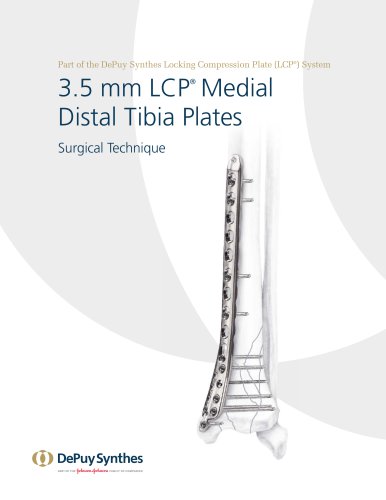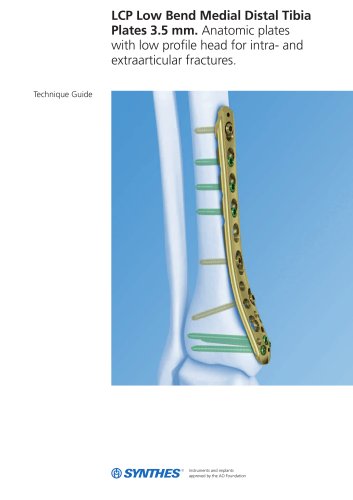 Website:
Depuy Synthes
Website:
Depuy Synthes
Group: Johnson & Johnson
Catalog excerpts
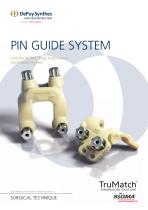
JOINT RECONSTRUCTION with the SIGMA® High Performance PERSONALIZED SOLUTIONS This publication is not intended for distribution in the USA. SURGICAL TECHNIQUE S^GMA
Open the catalog to page 1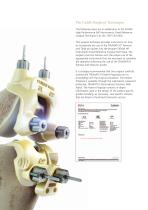
Pin Guide Surgical Technique The following steps are an addendum to the SIGMA High Performance (HP) Instruments, Fixed Reference Surgical Technique (Cat. No. 9075-02-000). This surgical technique provides instructions on how to incorporate the use of the TRUMATCH™ Femoral and Tibial pin guides into the broader SIGMA HP Instruments Fixed Reference Surgical Technique. The surgeon must be familiar with the proper use of the appropriate instruments that are necessary to complete the operation following the use of the TRUMATCH femoral and tibial pin guides. It is strongly recommended that the...
Open the catalog to page 2
TRUMATCH SOLUTIONS PIN GUIDE Basic Surgical Steps SIGMA Total Knee System steps shown. Tibial Preparation Step 1: Insert drill guides Step 2A: Tibial guide placement Step 2B: Tibial guide alignment Step 3: Use of uprod extension. Verification of V/V alignment and slope Step 4: Placement of anterior pins. Use of HP uprod Step 5: Removal of drill guide and pin guide. Anterior pins left in place Step 6: Proximal tibial resection Step 1: Insert drill guides Step 2: Femoral pin guide placement Step 3: Drill anterior and distal pin holes and remove pin guide Step 4: Position the distal femoral...
Open the catalog to page 3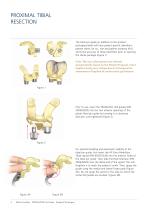
PROXIMAL TIBIAL RESECTION The tibial pin guide (in addition to the product packaging label) will have patient specific identifiers: patient name, lot no., size and patient anatomy (R/L). Verify the accuracy of these identifiers prior to opening the sterile package (Figure 1). Note: The size information was selected preoperatively based on the Patient Proposal. Final implant sizing may change due to intraoperative assessment of implant fit and/or joint gap balance. Prior to use, insert the TRUMATCH drill guides (P/N 200420925) into the two anterior openings of the plastic tibial pin guide by...
Open the catalog to page 4
With the knee flexed at 90 degrees, place the tibial resection guide and uprod assembly onto the proximal anterior medial aspect of the tibia and both plateaux. Avoid using excessive force to seat the guide. Apply most of the force anterior to posterior while holding the guide as described. To assist in the medial/lateral positioning of the tibial pin guide, refer to the last page of the Patient Proposal that contains a top view of the patient’s tibial surface. It is recommended to observe the red line shown in the Patient Proposal to the patient’s bone and to check alignment with the...
Open the catalog to page 5
PROXIMAL TIBIAL RESECTION After drilling the two anterior pins, the TRUMATCH drill guides are removed by twisting in a counter-clockwise direction, while leaving the two anterior pins in place (Figure 7). Remove the tibial pin guide by moving it up and pulling it away from the anterior fixation pins. Slide the appropriate L/R 0 degree HP Proximal Tibial Cutting Block over the anterior fixation pins through the “0” mm holes marked with a square. (Figure 8) If desired, confirm the cut orientation with the angelwing. If necessary, the block may be shifted 2 mm proximally or distally by...
Open the catalog to page 6
DISTAL FEMORAL RESECTION The femoral pin guide (in addition to the product packaging label) will have patient specific identifiers: patient name, lot no., size and patient anatomy (R/L). Verify the accuracy of these identifiers prior to opening the sterile package (Figure 9). Note: The size information was selected preoperatively based on the Patient Proposal. Final implant sizing may change due to intraoperative assessment of implant fit and/or joint gap balance. Prior to use, insert the TRUMATCH drill guides (P/N 200420925) into the two anterior and two distal openings of the plastic...
Open the catalog to page 7
DISTAL FEMORAL RESECTION Evaluate the placement of the guide. The correct position is found when there is minimal or no toggling/ rocking of the femoral pin guide. It is not uncommon to see a 1 to 2 mm gap around the periphery of the guide due to cartilage loss. Insert two anterior pins and drill two distal holes using the appropriate drill guides (Figure 12). The anterior holes will be used to place the HP distal femoral cutting block to perform the distal femoral cut. The distal holes set the femoral rotation and match the fixed reference pin placement of the SIGMA HP femoral A/P chamfer...
Open the catalog to page 8
Evaluate the distal cut using the reference guide or angelwing (Figure 14A). If needed, the block may be shifted 2 mm proximally or distally by selecting one of the appropriate offset holes adjacent to the “0” mm hole. For additional stability during the cut, an optional third, fixation pin can be placed through the cutting block in either the lower medial or lateral holes. Perform the distal femoral resection using a 1.19 mm thick saw blade (Figure 14B). Remove the HP Distal Femoral cutting guide and confirm the bone cuts are clean and without any under-cut bone fragments. Note: In order...
Open the catalog to page 9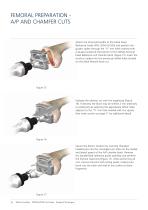
FEMORAL PREPARATION A/P AND CHAMFER CUTS Attach the Universal Handle to the Distal Fixed Reference Guide (P/N: 2004-20-920) and position the guide’s spikes through the “0” mm holes marked with a square located at the bottom of the SIGMA Femoral Fixed Reference A/P chamfer block (Figure 15). Insert the construct spikes into the previously drilled holes located on the distal femoral bone cut. Evaluate the anterior cut with the angelwing (Figure 16). If desired, the block may be shifted 2 mm anteriorly or posteriorly by selecting the appropriate offset holes adjacent to the “0” mm hole marked...
Open the catalog to page 10
Note: If the Distal Fixed Reference Guide (P/N: 2004-20-920) is unavailable, two fixation pins can be inserted in the previously drilled distal femoral holes and used to set the location of the HP Femoral A/P chamfer block. The TRUMATCH Femoral Pin guide is designed to position the pin holes posteriorly on the femur which maintains the ability to move the block to resect 2 mm more bone anterior or 2 mm more bone posterior with the same size block regardless of whether the surgeon preference is anterior-down or posterior-up. However, if it is necessary to downsize the femoral component, the...
Open the catalog to page 11All Depuy Synthes catalogs and technical brochures
-
ZERO-P NATURAL™PLATE
5 Pages
-
2.0 mm LCP® Distal Ulna Plate
20 Pages
-
SYNFLATE SYSTEM
3 Pages
-
2.4 mm VA LCP™
4 Pages
-
Building on Success
16 Pages
-
HEALIX ADVANCE
4 Pages
-
RADIUS OF CURVATURE
3 Pages
-
Introducing The Variable Angle
12 Pages
-
HEALIX Anchor™ 3.4 mm
2 Pages
-
Small Battery Drive II
4 Pages
-
HEALIX ADVANCE
4 Pages
-
3.5 mm LCP™ Medial
15 Pages
-
Titanium Sternal Fixation System
34 Pages
-
MatrixRIB®FixationSystem
86 Pages
-
Mandible Trauma Solutions
2 Pages
-
Power line II
4 Pages
-
Concorde
28 Pages
-
LCP Intercarpal
31 Pages
-
LCS® COMPLETE™
2 Pages
-
Synthes TPLO.
8 Pages
-
SynFix-LR System
56 Pages
-
ATB Anterior Tension Band Plate
32 Pages
-
CONDUIT™
15 Pages
-
Brochure_FINAL
2 Pages
-
DePuy Synthes
81 Pages
-
Anspach
3 Pages
-
Orthopedic Foot Instruments
32 Pages
-
PINNACLE® Hip Solutions
12 Pages
-
Corail
24 Pages
-
S-ROM® NOILES™
68 Pages
-
TRI-LOCK® Product Rationale
12 Pages
-
Reclaim Surgical Technique
44 Pages
-
Speed
2 Pages
-
attune
80 Pages
-
HAMMERLOCK® 2
2 Pages
-
DePuy Glenoid Solutions
2 Pages
-
Trauma Solutions. Elbow
4 Pages
-
Polar
4 Pages
-
Alveolar Distractor.
4 Pages
-
Piezoelectric System
4 Pages
-
Air Power Line II
6 Pages
-
LCP Clavicle Hook Plate
4 Pages
-
P F N A
8 Pages
-
SKILL, DEDICATION,
16 Pages
-
Orthopaedics. Overview
20 Pages
-
DURALOC
16 Pages
-
Marathon Cemented Cup
20 Pages
-
REEF Surgical Technique
16 Pages
-
MatrixNEURO
8 Pages
-
Anspach XMax
4 Pages
-
Anspach eMax 2 Plus
4 Pages
-
Small Electric Drive
4 Pages
-
Air Pen Drive
4 Pages
-
Colibri II
4 Pages
-
Spine
25 Pages
-
Expert Hindfoot Arthrodesis Nail
48 Pages
-
LCP Distal Fibula Plates
32 Pages
-
TomoFix
60 Pages
-
Expert Tibial Nail PROtect
16 Pages
-
Expert Tibia Nail
84 Pages
-
Sacral Bars
16 Pages
-
Pelvic C-Clamp
20 Pages
-
Low Profile Pelvic System
16 Pages
-
Proximal Femoral (Hook) Plate
24 Pages
-
LCP
24 Pages
-
PFNA
112 Pages
-
HCS 1.5, 2.4, 3.0
36 Pages
-
LCP Wrist Fusion
32 Pages
-
LCP Compact Hand
28 Pages
-
VA-LCP Elbow
48 Pages
-
Distal Radius
44 Pages
-
Olecranon
30 Pages
-
LCP Hook Plate
28 Pages
-
DHP & Olecranon
4 Pages
-
LCP S-A
4 Pages
-
Epoca
4 Pages
-
Philos
32 Pages
-
MultiLoc
68 Pages














